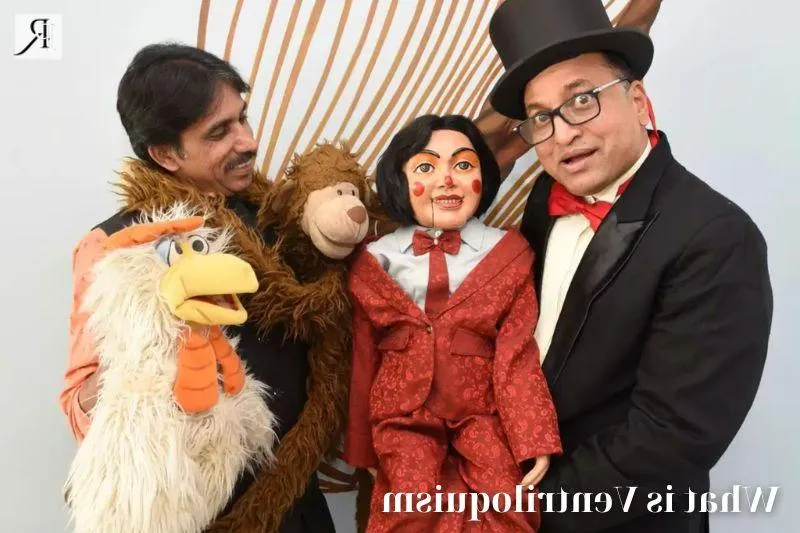Have you ever wondered how ventriloquists are able to converse with their cheeky puppets without moving their lips? Welcome to the captivating world of ventriloquism! It’s not just about speaking up; It’s an art form that combines performance, precision, and lots of practice.
Let’s explore the mystery and explore What is ventriloquism?.
What is ventriloquism?

Have you ever watched a comedy show and found yourself chatting with a puppet, then realized – hey, that’s not a real person?
Well, my friends, you have just learned the age-old art of ventriloquism! At its core, ventriloquism is a dramatic art in which a person (the ventriloquist) creates the illusion that their voice is coming from somewhere else, typically a puppet prop, also known as Is called fake.
This isn’t your typical rabbit-out-of-the-hat trick; it’s a sophisticated blend of acting, mimicry and comedic timing.
The ventriloquist speaks in a way that makes it appear as if the dummy is speaking – all without moving his lips – leaving the audience confused and, at times, completely confused.
Types of ventriloquism

Classic comedy act: This is the bread and butter of ventriloquism, where the performer engages in a humorous dialogue with their dummy. Punch lines fly faster than wigs in a storm, and the audience is often part of the joke.
Musical ventriloquism: Have you ever seen a fake belt that plays a tune? These ventriloquists took it to the next level by injecting vocals into the mix, while keeping their lips sealed. It looks like Looking for American talent but with more wood.
Educational ventriloquism: Who says learning can’t be fun? Some ventriloquists lean their performances towards teaching children (and adults!) about various topics, making them the great teachers we never had.
Ventriloquism therapy: You read that right. Some use ventriloquism in therapeutic settings, helping individuals open up and express difficult-to-express emotions. It’s like a puppet-controlled psychology session.
Elements of ventriloquism

Illusion of voice: The foundation of ventriloquism is the ability to project one’s voice. It is the art of manipulating and transmitting the voice in such a way that it appears to come from the dummy and not from the ventriloquist.
Lip control: A ventriloquist’s lips are like Fort Knox – nothing can penetrate. The skill lies in speaking without any noticeable lip movements, and believe me, it is not as easy as it looks.
Dialogue and script writing: A witty script is the secret sauce of any ventriloquist act. It’s all about breakthroughs, comebacks and timing. And remember, a little improvisation goes a long way.
Puppet manipulation: The dummy is more than just a companion; it’s the ventriloquist’s partner in crime. Master the puppet’s movements to mirror it personality is important. It’s what turns a piece of wood into a character you want to drink beer with.
Interact with the audience: The true test of a ventriloquist is how well they can draw the audience into their world. It’s an interactive experience and the best in the business know how to make each audience member feel part of the show.
Technical skills: We’re talking about voice modulation, precision, and the ability to instantly switch personalities. This is the mechanical aspect of ventriloquism that underlies the performance.
How to do ventriloquism: A beginner’s guide to voice training
Start with ventriloquism
Master the basics:
- Find your voice: Before you pick up a puppet, practice your voice. Start by practicing speaking without moving your lips. Use a mirror to watch for any unwanted movements.
- The Ventriloquist’s Alphabet: There are certain letters (B, F, M, P, Q, V, and W) that require natural lip movement to pronounce. Ventriloquists use substitute words for letters that have similar sounds but do not require lip movement. For example, instead of a B sound, you can use a soft D or G sound. Experiment to find what works for you.
Choose your dummy: Choose a puppet or mannequin that fits your personality or comedic style. This character will become your stage alter ego, so choose wisely!
Build your statute: Develop a habit. Start simply with a few jokes or a funny story, making sure there is clear dialogue between you and your puppet.
Tips for honing your ventriloquism skills
- Practice practice practice: Set aside time each day to work on your technique. The more you practice, the more natural it will become.
- Record yourself: Listening to recordings can help you detect errors and improve your speaking.
- Work on puppetry: The act of persuasion is not just about the voice; it’s also about bringing your mannequin to life. Practice your movements and expressions to create your fake personality.
- See experts: Study professional ventriloquists to understand their timing, humor, and puppet control. Legends like Edgar Bergen, Jeff Dunham and Terry Fator can provide a lot of inspiration.
An example of ventriloquism
Classical Theater Act
Edgar Bergen and Charlie McCarthy: Bergen was one of the first ventriloquists to achieve celebrity fame, along with his daring wooden companion Charlie McCarthy. They will have humorous and sarcastic exchanges that will delight audiences of all ages.
Paul Winchell and Jerry Mahoney: Winchell’s dummy Jerry is known to be a mischievous boy, often leading to humorous situations on stage.
Modern entertainment
Jeff Dunham and Achmed The terrorist is dead: Dunham modernized ventriloquism, creating characters with strong personalities and a sense of relevance to contemporary issues, albeit in a comedic context.
Terry Fator: America’s Got Talent winner, Fator uses his ventriloquism abilities along with impressive singing ways, from Elvis to Maroon 5.
Frequently asked questions about ventriloquism

Do ventriloquists really throw their voices away?
No, the idea of throwing away my voice is just an illusion. Ventriloquists skillfully use their voices and puppets to create the impression that the voice is coming from somewhere else.
Can anyone learn ventriloquism?
Yes, with practice and dedication, almost anyone can learn the basics of ventriloquism. It requires patience and the development of specific vocal skills.
How long does it take to learn ventriloquism?
The time it takes to learn ventriloquism varies greatly depending on natural talent, dedication to practice, and the amount of time invested in learning the craft. Some of the basics can be learned within a few months, but mastering the art can take years.
Why do ventriloquists use dummies?
Ventriloquists use dummies as visual accents to help the audience interact with the performance. The dummy acts as a separate character with its own personality, helping to create a more dynamic and interesting action.
Is ventriloquism possible without puppets?
That’s right, ventriloquism can be performed without a puppet, using inanimate objects, or even creating the impression that the voice is coming from another person or part of the environment. However, the use of puppets is more popular because of its entertainment value.
Conclusion
So there you have it – a glimpse behind the ventriloquism curtain. It is the interplay of skill, patience and humor that brings those lifeless characters to life. Whether your goal is to become the next celebrity on stage or just want to impress your friends, remember that the essence of ventriloquism lies in the joy it brings to both the performer and the performer. performer and audience.
Thank you for reading this article with rachelparris.com
Do you want to laugh more with comedy? The list below is your playground.
Categories: omedian
Source: hubm.edu.vn










